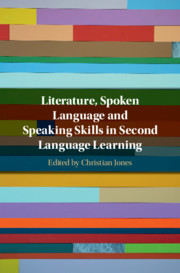Book contents
- Literature, Spoken Language and Speaking Skills in Second Language Learning
- Literature, Spoken Language and Speaking Skills in Second Language Learning
- Copyright page
- Contents
- Figures and Tables
- Contributors
- Foreword
- Acknowledgements
- 1 Introduction
- Part I Literature and Spoken Language
- 2 The Realism of Conversation in Literature
- 3 Using Literature in Text-Driven Materials to Help Develop Spoken Language Awareness
- 4 Literature, TV Drama and Spoken Language Awareness
- 5 Haiku and Spoken Language: Corpus-Driven Analyses of Linguistic Features in English Language Haiku Writing
- 6 Screenplays as a Pedagogical Medium for Cultivating EFL Learners’ Metapragmatic Awareness of Speech Acts in Spoken English
- Part II Literature and Speaking Skills
- Index
- References
3 - Using Literature in Text-Driven Materials to Help Develop Spoken Language Awareness
from Part I - Literature and Spoken Language
Published online by Cambridge University Press: 18 October 2019
- Literature, Spoken Language and Speaking Skills in Second Language Learning
- Literature, Spoken Language and Speaking Skills in Second Language Learning
- Copyright page
- Contents
- Figures and Tables
- Contributors
- Foreword
- Acknowledgements
- 1 Introduction
- Part I Literature and Spoken Language
- 2 The Realism of Conversation in Literature
- 3 Using Literature in Text-Driven Materials to Help Develop Spoken Language Awareness
- 4 Literature, TV Drama and Spoken Language Awareness
- 5 Haiku and Spoken Language: Corpus-Driven Analyses of Linguistic Features in English Language Haiku Writing
- 6 Screenplays as a Pedagogical Medium for Cultivating EFL Learners’ Metapragmatic Awareness of Speech Acts in Spoken English
- Part II Literature and Speaking Skills
- Index
- References
Summary
This chapter advocates the use of contemporary literature to help second language (L2) learners to become more aware of how their target language is typically used in speech to achieve intended effect. The approach being proposed is a text-driven approach in which a written or spoken text is used initially to engage the learners affectively and cognitively and then as a source for discovery activities designed to help the learners to become aware of how a particular linguistic or discourse feature is being used to achieve intended effects. The emphasis is on spoken interaction, and the focused feature is investigated further in learner out-of-class activities. After describing, justifying and exemplifying the proposed approach, the chapter reports the results of a research project seeking to find out the responses of language teachers to the approach. Language teachers in a number of different countries were asked to rate the potential value and the contextual feasibility of such an approach by responding to units of materials driven by the approach. In the conclusion to the chapter, recommendations are made with regard to materials development, to teacher and learner adaptation of materials and to assessment of learner achievement.
- Type
- Chapter
- Information
- Publisher: Cambridge University PressPrint publication year: 2019

